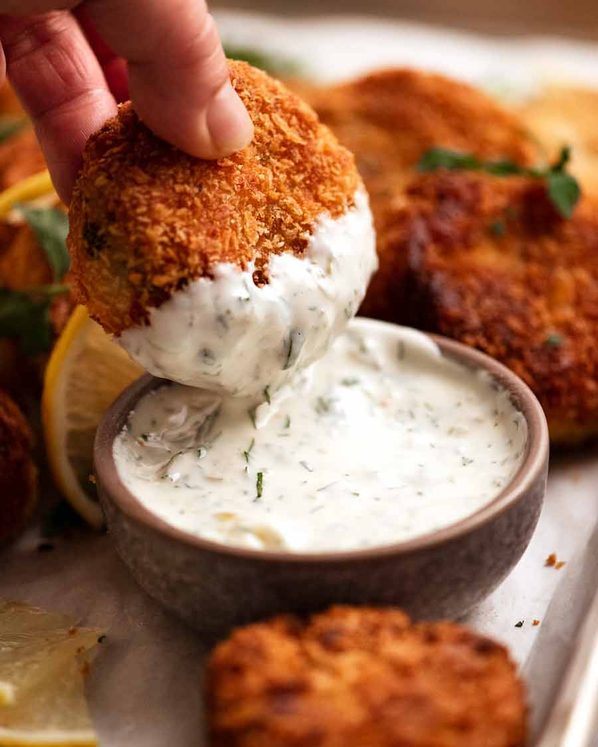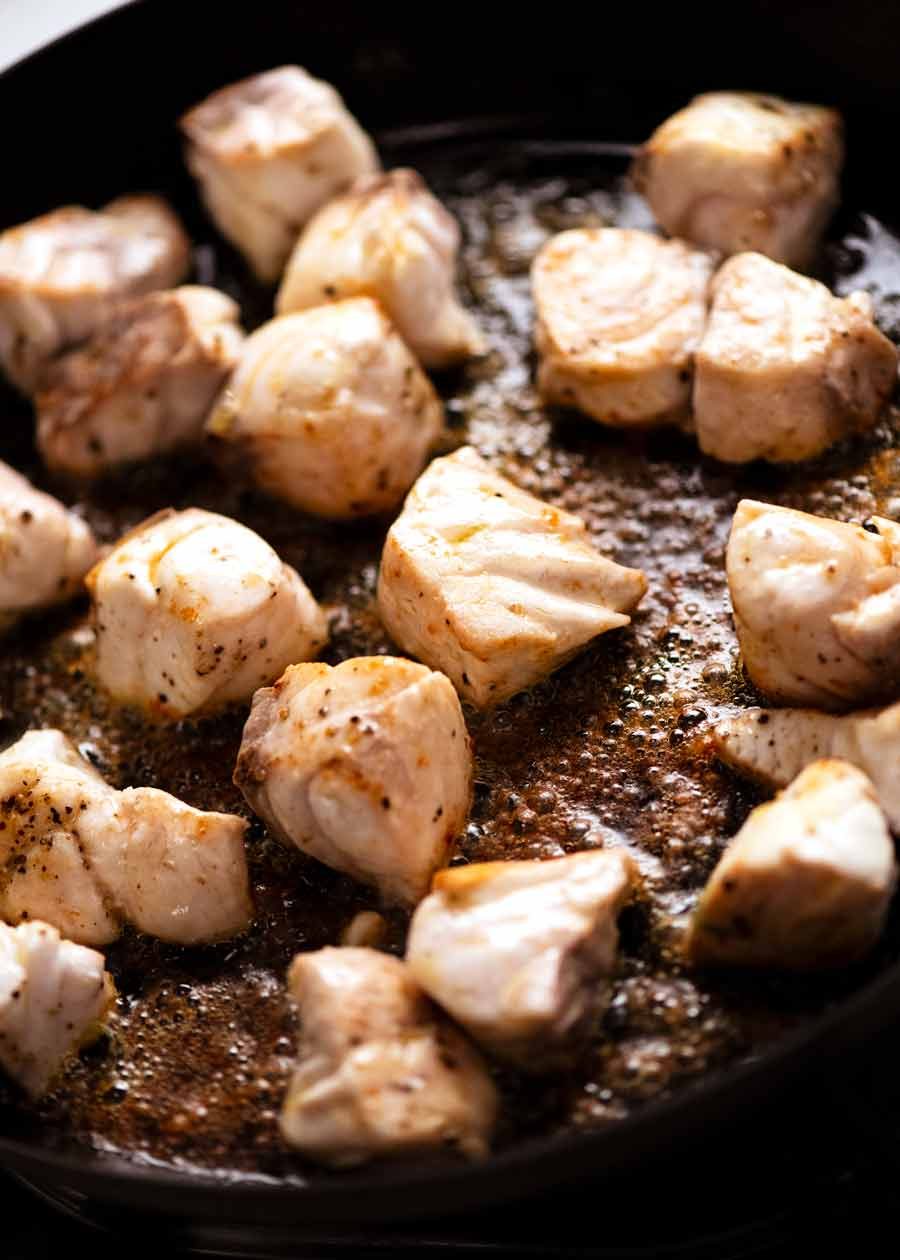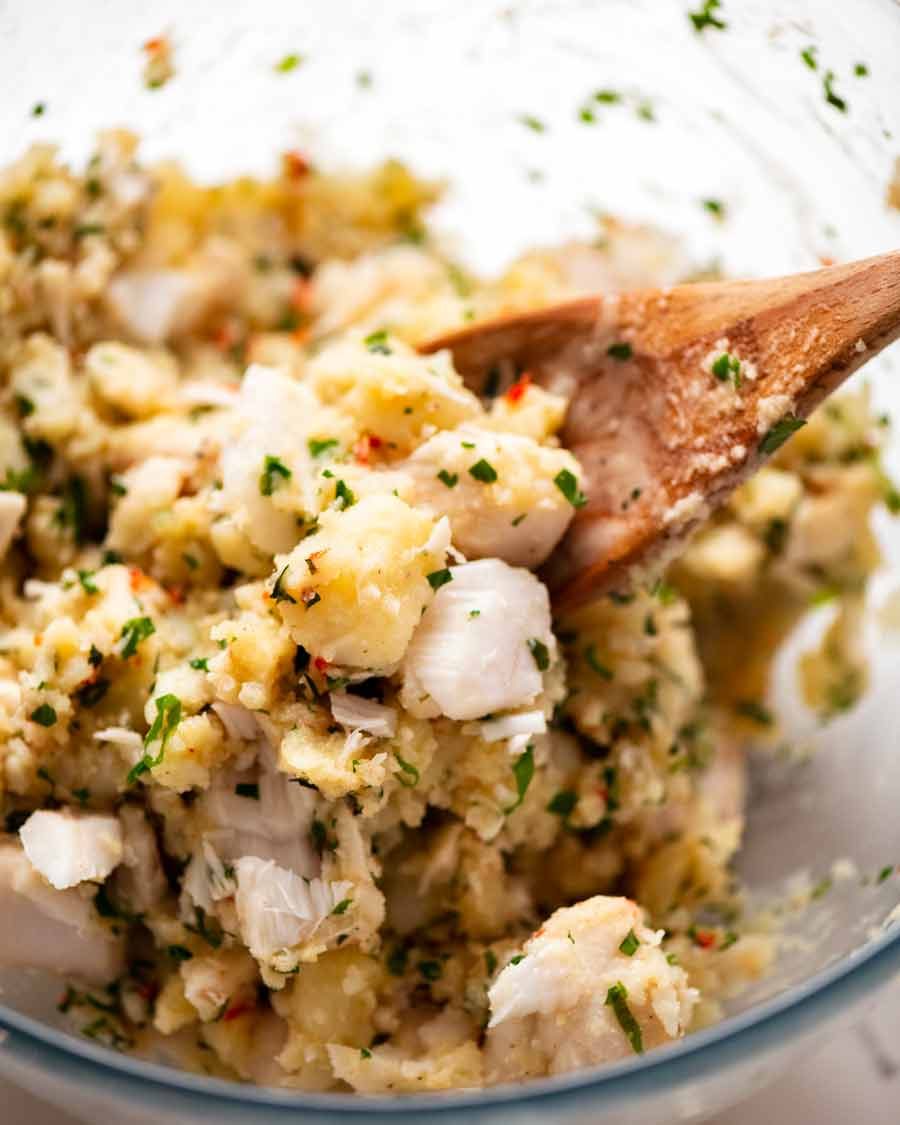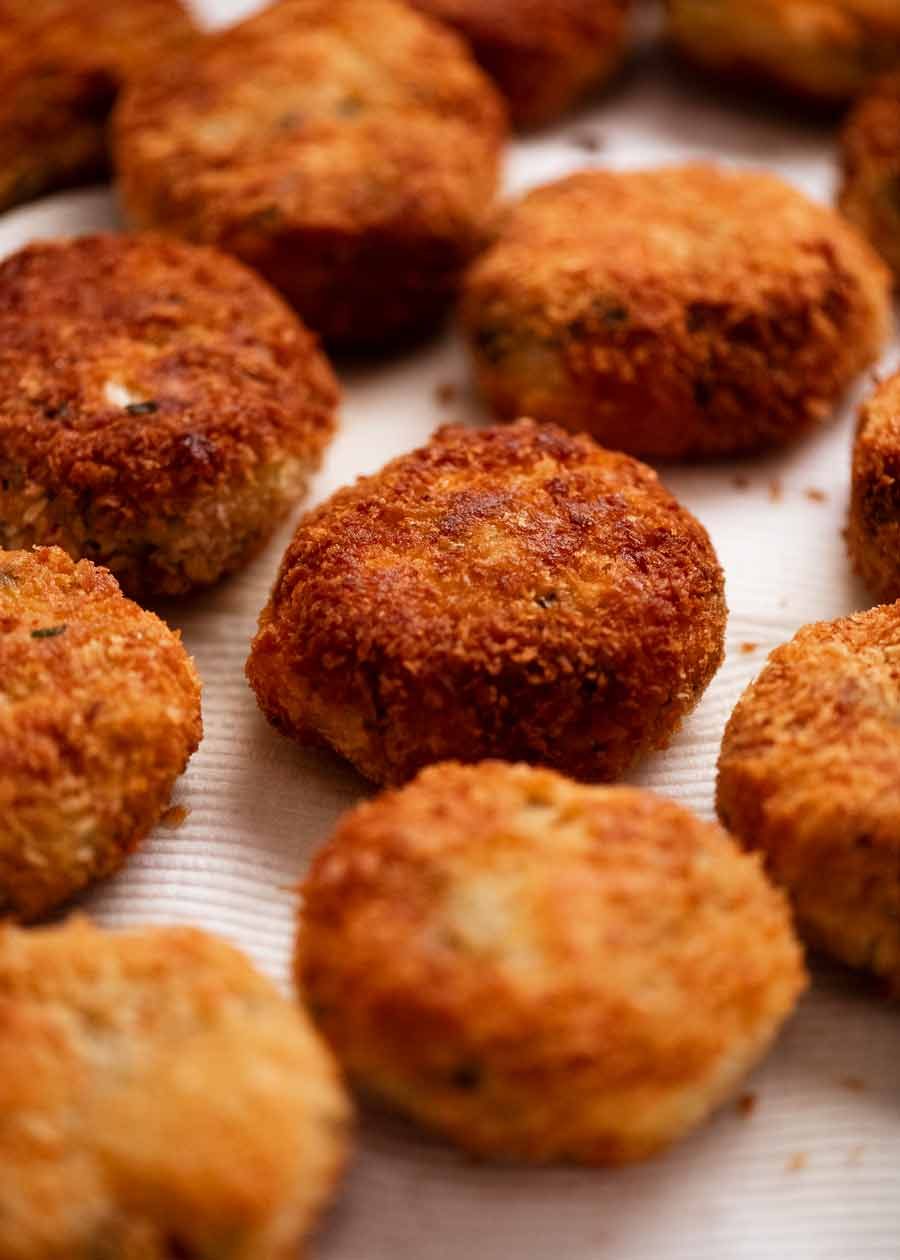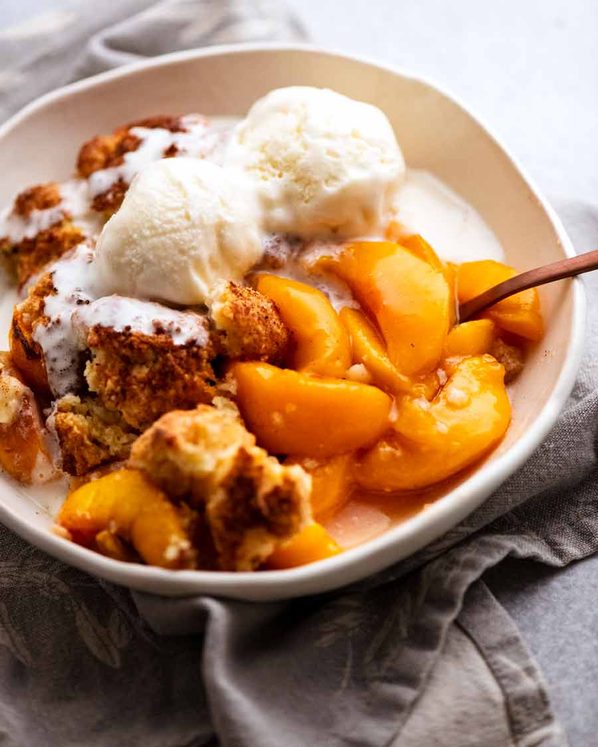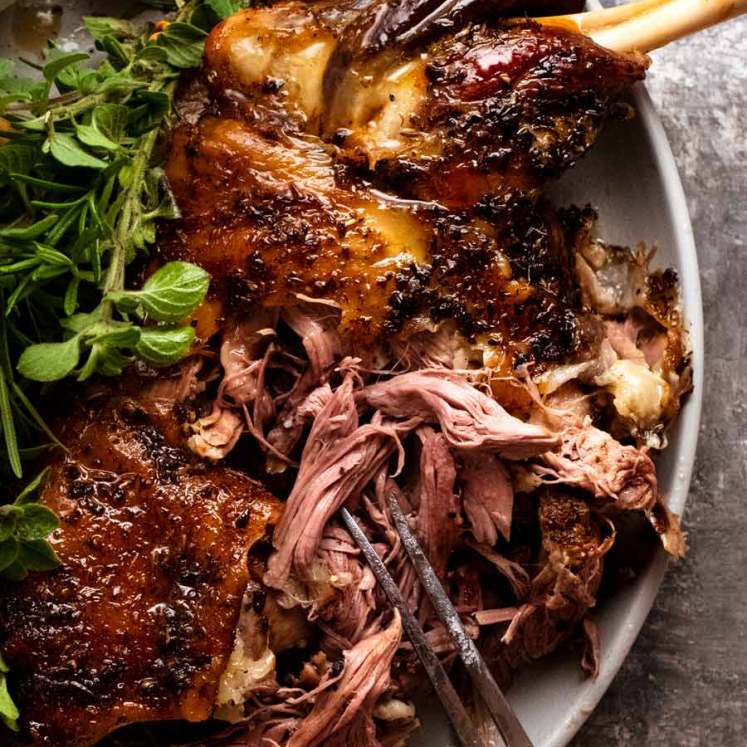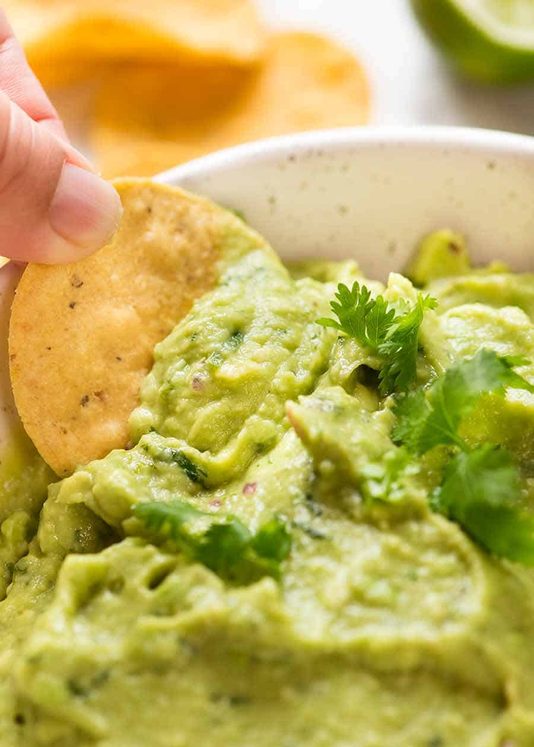You’ll find plenty of fish cake recipes floating around. But there are good fish cakes and then there are great fish cakes! The trick is to keep the potato chunky and the fish in big flakes rather than letting it all turn into a mush. Meanwhile, adding garlic, chilli, green onion and thyme to the mix keeps these full of flavour!
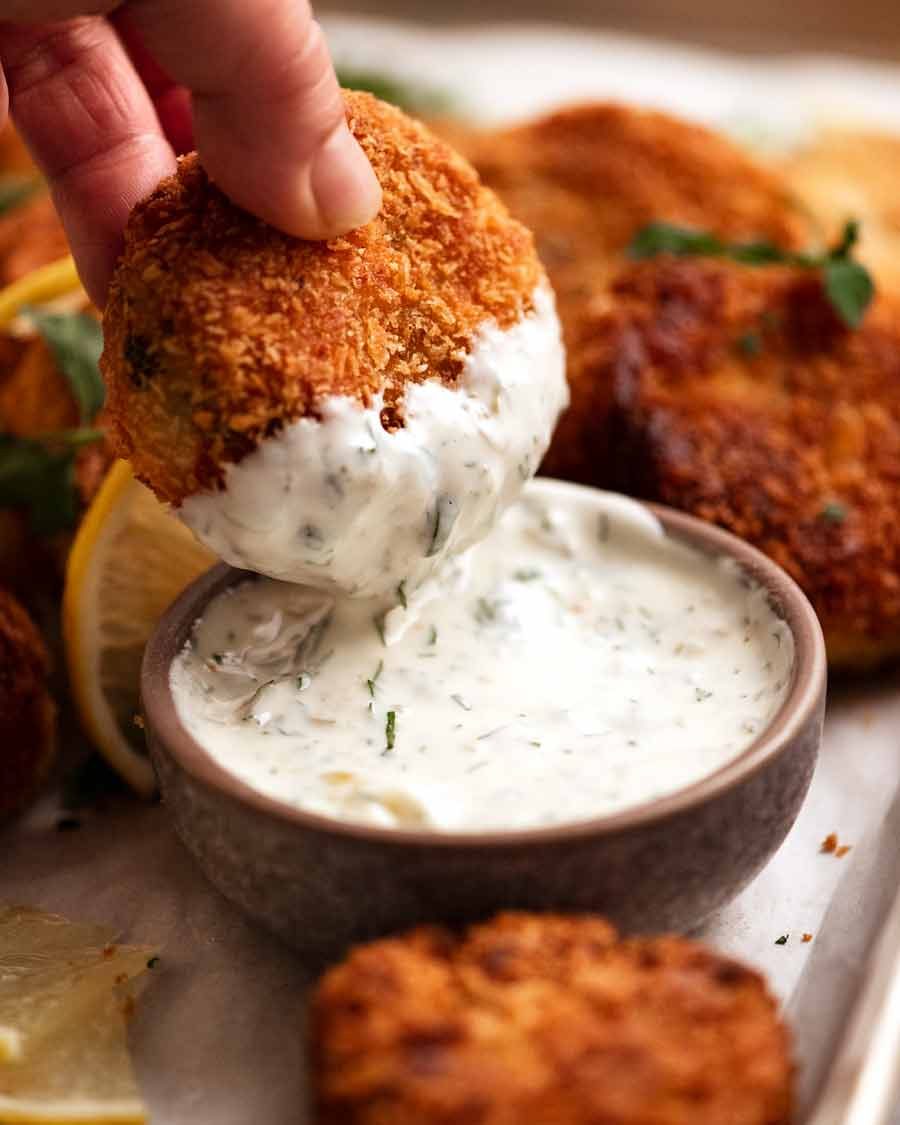
Fish cakes
Fish cakes make a refreshing change from the usual pan-seared methods that I typically default to when it comes to fish recipes.
It’s also a good way to make less fish go further because the fish is mixed with some kind of padding starch – potato in this case. 500g / 1lb fish used in these fish patties will comfortably feed 4 adults, if not 5, compared to a standard serving size for a piece of fish is 180g / 6oz per person.
Plus, let’s just state the obvious: Anything crumbed and pan fried until crunchy and golden is always a winner, right? Especially when the underneath that crunchy exterior is buttery, slightly chunky mashed potato and juicy chunks of fish!
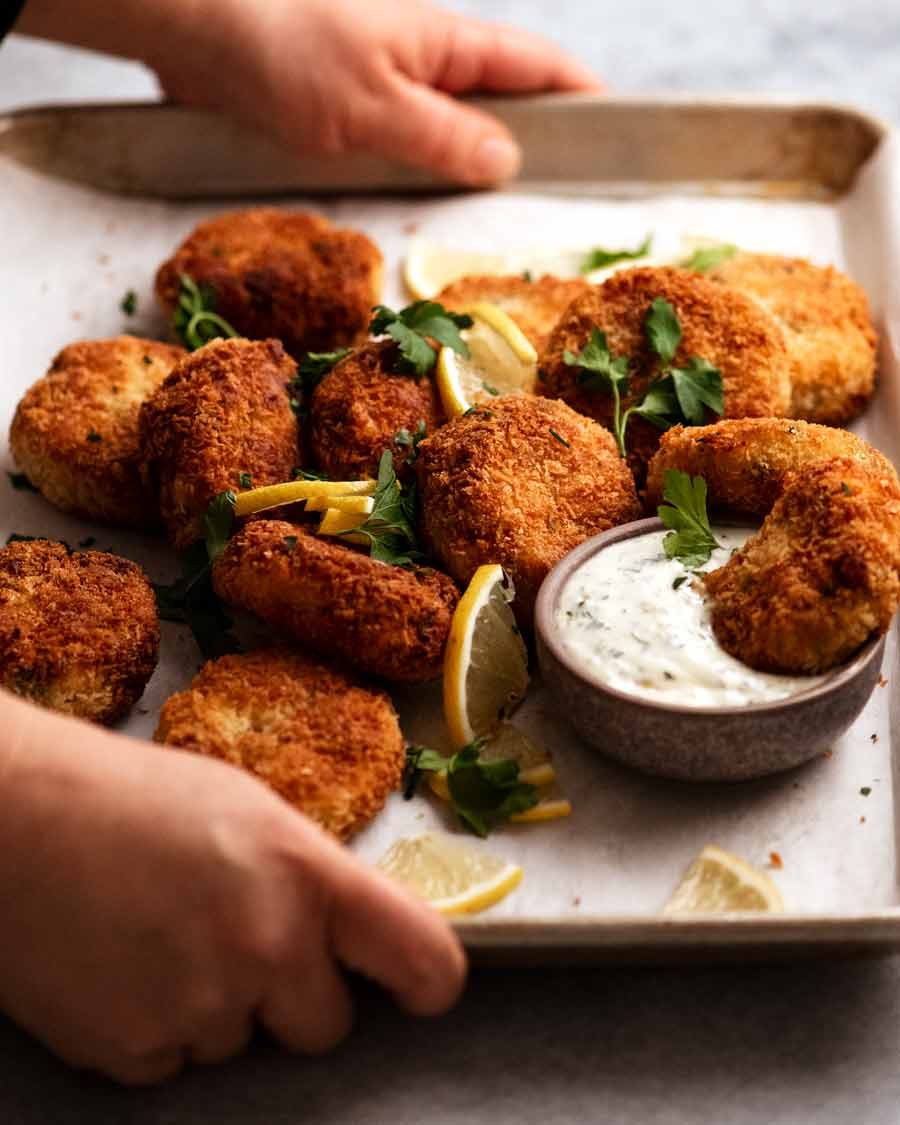
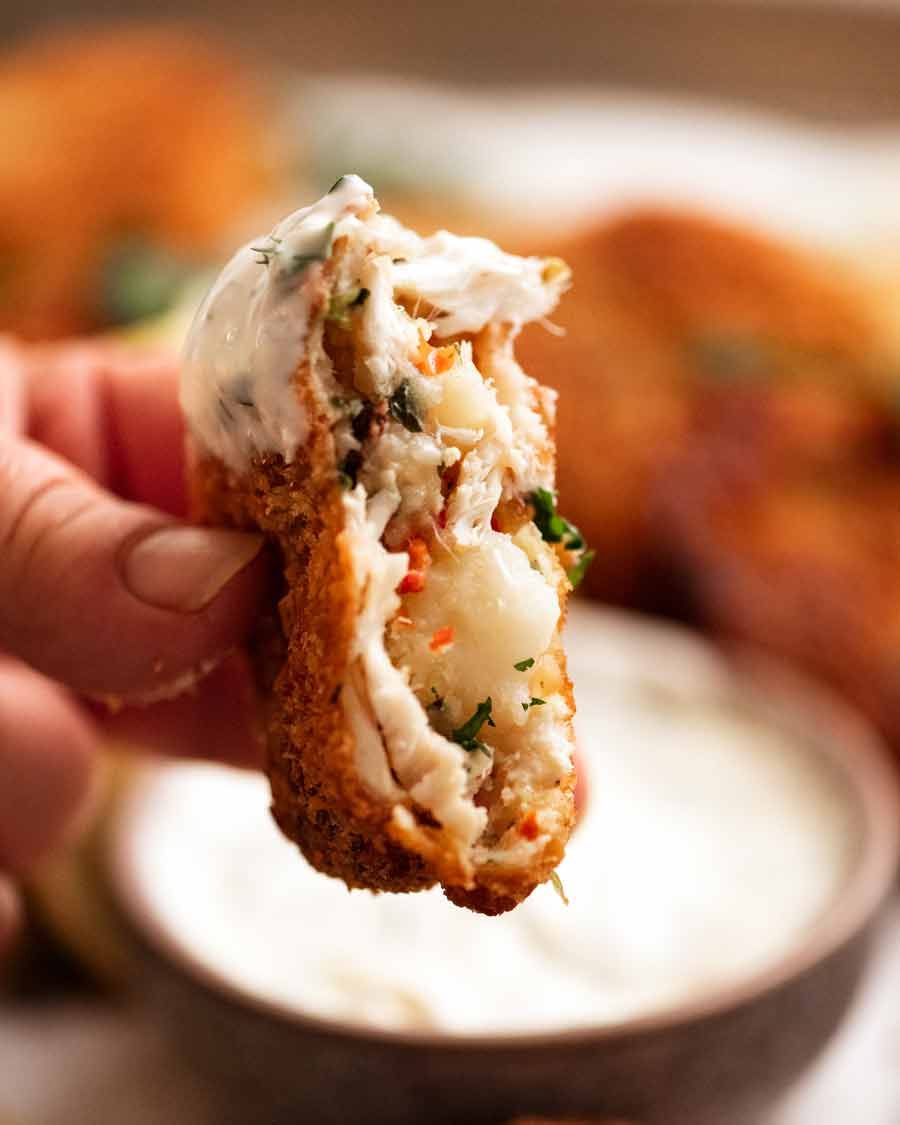
Ingredients in Fish Cakes
Here’s what you need:.
1. The Fish

-
Butter, salt and pepper – For pan frying. Nothing more needed because we’re mixing flavours right into the fish cakes, see below!
Best fish for these fish cakes
Any firm white fish fillets suitable for pan frying will work here. Even salmon will work great! Here’s are suggestions for common fish in my primary readership countries that is ideal for these fish cakes:
-
Australia: Trevalla/Blue eye cod, Hapuka, Barramundi, Jewfish/Mulloway, Flathead, Ling, Ocean Perch, Salmon, Snapper (large 1.2kg/2.5lb+), Ocean trout (not river trout).
-
US: Tilapia, Cod, Alaskan pollock, Catfish.
-
UK: Cod, Pollack, Hake, Sea Bass, Haddock, Salmon.
Canned tuna and salmon will also work here. Keep them in nice big chunks. Also, there’s no need to cook them.
Fish to avoid
-
Fish that dries out easily – this includes king fish, tuna, sword fish, mahi mahi.
-
Oily fish that also tends to have quite a “fish” flavour, as sardines, mackerel and river trout.
-
Fish that’s too small or delicate for this recipe. This includes: Bream, Whiting, John Dory, Orange roughy (deep sea perch), Flounder, Sole, Turbot, Halibut, Monkfish / Stargazer (well, it works, but it’s a premium fish so I wouldn’t waste it on fish cakes! This Monkfish recipe is more worthy!)
2. Ingredients for the Fish Cakes
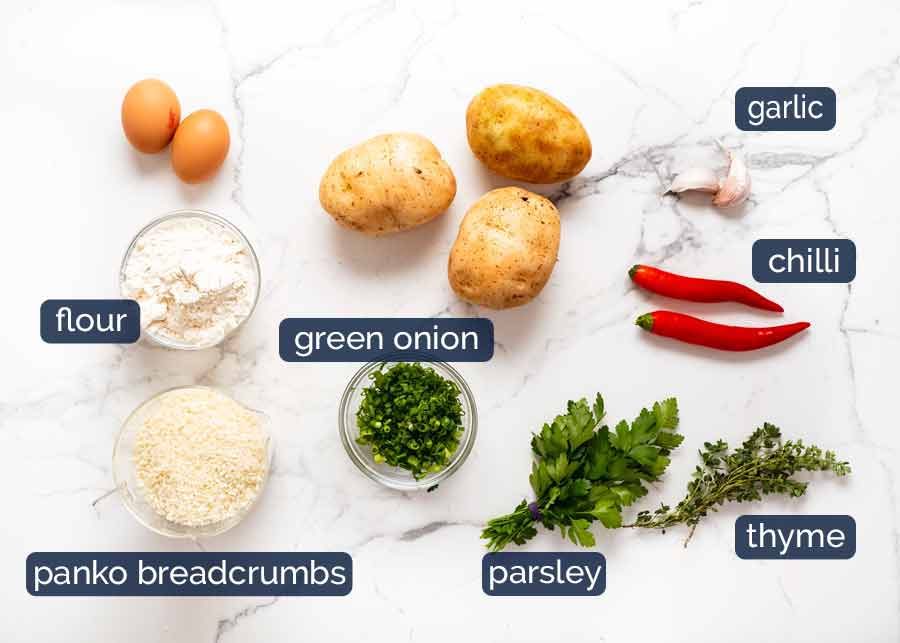
-
Potato – This is used to bind and fill out the fish cakes. Any starchy or all-rounder potatoes will work fine here. It’s better to avoid waxy potatoes if you can but to be honest, even waxy potatoes will work ok.
-
Garlic, chilli, green onion, parsley and thyme – These are the flavourings for the fish cakes. This might sound modest on the flavour scale, but when you sauté it in the leftover butter after pan-searing the fish, all that bubbly goodness gets mashed with the potato and very good things happen indeed!
-
Egg, flour and panko breadcrumbs – This is for that golden crunchy coating you’ve been eyeing on the fish cakes!
How to make (really good!) Fish Cakes
You’ll find recipes online that are simpler with fewer steps. But I promise the (small!) extra effort is worth it – and I explain why!
1. Fish cake mixture
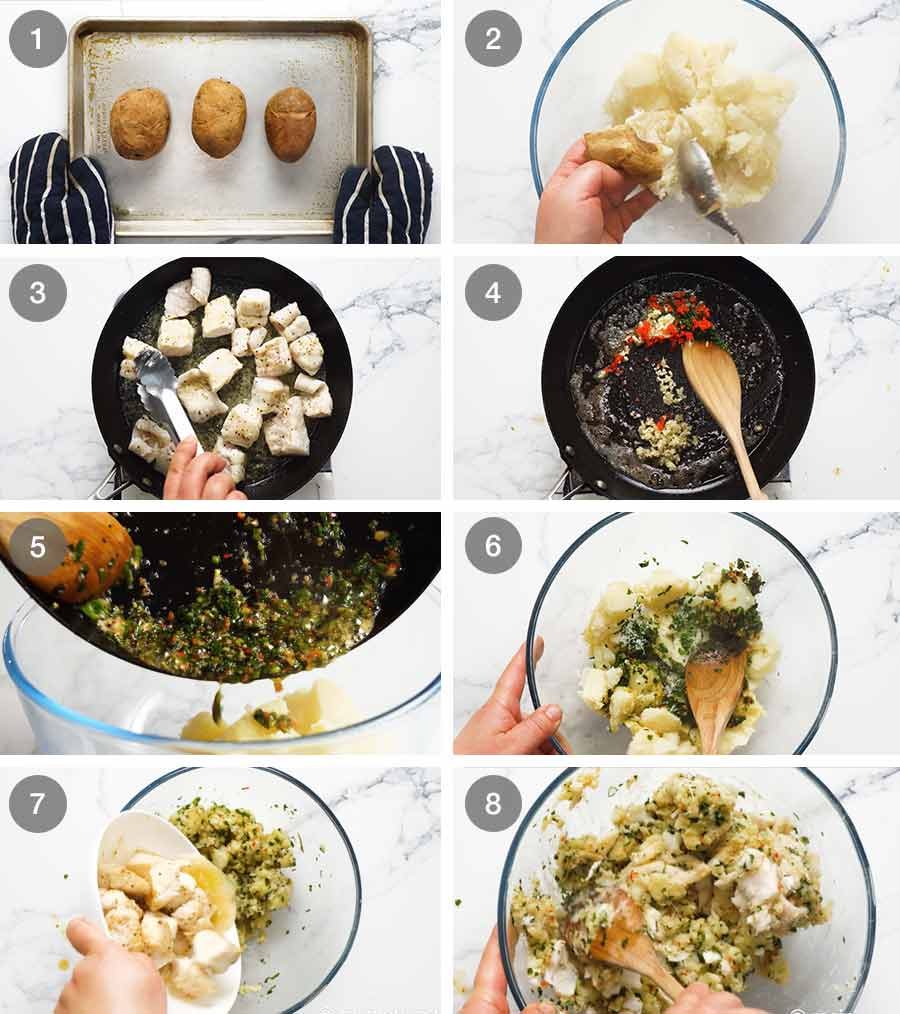
-
Bake potatoes for 75 minutes until they offer no resistance when pierced with a knife. Baking whole potatoes works better than boiling cubes of peeled potato because they stay dry and the potato flavour isn’t diluted by the water.
-
Scoop out potato flesh in a bowl.
-
Pan-sear large cubes of fish in butter, then remove from the pan.
-
Sauté garlic –In the same pan and using the leftover butter, sauté the garlic, chilli, green onion and thyme until the garlic is golden.
-
Pour this glorious, flavour-loaded buttery mixture into the potatoes. This is a key step for flavour in the fish patties because the butter has all the tasty flavour from pan-frying the fish.
-
Roughly mash potato – Add the parsley, some salt and pepper then roughly mash. Emphasis here on the word roughly. We don’t want very smooth mashed potato here because then the inside of the fish cake becomes quite soft and baby-food-like. We want some lumps for texture which creates a nice contrast to the soft flakes of fish.
-
Add fish – Add the fish, including any juices pooled in the bowl / tray.
-
Gently stir the fish in, taking care not to break up the delicate fish flakes too much. We want some nice big flakes of fish in our fish cakes, not just an unrecognisable paste of potato and disintegrated fish!
2. Forming fish cakes, crumbing and cooking

-
Scoop out mixture –Use a 1/4 cup measure to scoop out that much fish cake mixture (about 60g) and pack it in firmly into the cup.
-
Form patties –Turn the mixture out onto your hand then form patties. (Tip: If you turn the mixture out into your hand it will mostly hold its shape which makes it very easy to shape into patties).
-
Crumbing, dust with flour – To coat the fish cakes in panko breadcrumbs, start by coating in flour. Roll to coat both sides and don’t forget the edges. Nobody wants fish cakes with naked edges – we need golden crumbs all over!!
-
Egg – Next, dip the fish cake into the beaten eggs and let the excess drip off.
-
Panko breadcrumbs – And finally, place it in a bowl of panko breadcrumbs. Spoon some breadcrumbs over then use your hands to pat it on to adhere as best you can. Pick the fish cake up and let the excess breadcrumbs fall off.
Repeat with remaining fish cakes. Now we’re ready to cook them!
-
Pan fry – Firstly, pan fry until golden on both sides.
Making the edges golden –If you’re pedantic like me, stand the fish cakes on edge and make the sides golden too, rolling the cakes slowly in the oil to give it colour all the way around. This is purely for visual purposes because the oil splashing as the flat sides cook and subsequent baking step do make the edges crunchy. But without specifically pan-frying the sides, they won’t go golden.
-
Remove once the fish cakes are golden on each side. It only takes around 1 1/2 minutes. Transfer them to a paper towel-lined tray to absorb excess oil, then continue cooking the remaining fish cakes.
At this stage, the fish patties won’t be that warm inside, so we’re going to finish them off in the oven. This method of cooking is also handy because you can serve a whole batch of piping hot fish cakes at once.
-
Bake for just 10 minutes at 200°C / 390°F (180°C fan) to make the middle of the fish cakes hot and also to reheat the first batch you cooked to piping hot again!
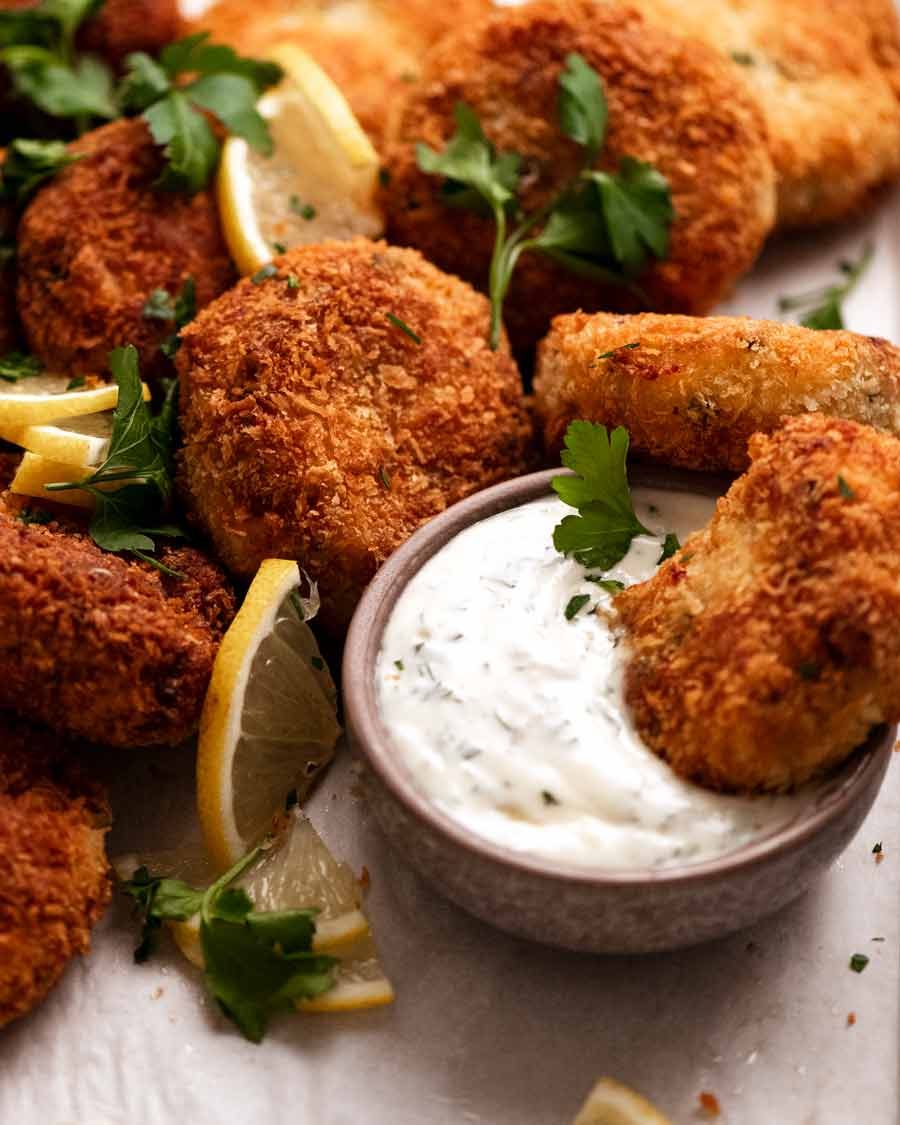
Sauce for Fish Cakes
You’ll find these fish cakes are moist and flavourful enough that you’ll be happy to devour them straight off the tray, no dipping sauce required.
However, as regular readers know, I’m a sauce gal. 🤷🏻♀️ Tartare sauce is classic and my sauce of choice, though any seafood sauce will be terrific such as Marie Rose, Seafood Sauce and our Family Seafood Dipping Sauce. Find all these sauces here.
But if you’re scrambling, even just plain mayonnaise will work a treat (Kewpie is my favourite, followed by whole egg brands like Hellmans), else sour cream or yogurt.
Even ketchup / Aussie tomato sauce is great. Don’t ever let anyone tell you what you should or should not dip your fish cakes into!! – Nagi x
Watch how to make it
Hungry for more? Subscribe to my newsletter and follow along on Facebook, Pinterest and Instagram for all of the latest updates.

Really good Fish Cakes
#wprm-recipe-rating-0 .wprm-rating-star.wprm-rating-star-full svg * { fill: #343434; }#wprm-recipe-rating-0 .wprm-rating-star.wprm-rating-star-33 svg * { fill: url(#wprm-recipe-rating-0-33); }#wprm-recipe-rating-0 .wprm-rating-star.wprm-rating-star-50 svg * { fill: url(#wprm-recipe-rating-0-50); }#wprm-recipe-rating-0 .wprm-rating-star.wprm-rating-star-66 svg * { fill: url(#wprm-recipe-rating-0-66); }linearGradient#wprm-recipe-rating-0-33 stop { stop-color: #343434; }linearGradient#wprm-recipe-rating-0-50 stop { stop-color: #343434; }linearGradient#wprm-recipe-rating-0-66 stop { stop-color: #343434; }
Ingredients
Fish:
- 500g / 1 lbwhite fish fillets, skinless boneless, cut into 3cm / 1.2″ pieces (Note 1)
- 60g / 4 tbspunsalted butter
- 1/2tspsalt
- 1/4tspblack pepper
Fish cakes:
- 800g / 1.6 lbpotatoes – Sebago (Aus), Russet (US), Maris Piper / King Edwards (UK) (Note 2) (makes 500g flesh)
- 2garlic cloves, finely minced
- 1/2cupgreen onion, finely sliced (~1 large stem)
- 2large red chillis, deseeded and finely chopped (can omit)
- 1tbspthyme leaves, chopped
- 1tbspparsley, finely chopped
- 3/4tspsalt
Crumbing and cooking:
- 1cupflour
- 2eggs, lightly whisked
- 1 1/4cupspanko breadcrumbs(sub ordinary breadcrumbs)
- 1cupvegetable or canola oil, for frying (~ 1cm / 0.4″ depth)
Instructions
Bake potatoes:
-
Bake potatoes in a 220°C / 430°F (200°C fan) oven for 75 minutes or until they can be pierced with a knife with no resistance. Cut in half and scoop flesh out into a large bowl.
-
Turn oven down to 200°C / 390°F (180°C fan) – fish cakes are finished in the oven.
Cook fish (while baking potatoes):
-
Set a rack over a tray. Sprinkle fish with salt and pepper.
-
Melt butter in a large non-stick skillet over medium high heat. Add half the fish and cook, turning, for 4 minutes in total. It should be just cooked inside (ie. flakes easily) but not golden.
-
Transfer to rack to cool. Repeat with remaining fish.
Fish Cake Mixture:
-
Sauté garlic: In the same skillet, add garlic, chilli ,thyme and green onion into the leftover butter. Cook for 1 minute until garlic is golden, then pour over the potato, being sure to scrape out every drop of butter!
-
Roughly mash potato: Add parsley and salt, then use a wooden spoon to roughly mash the potato. Don’t use a potato masher, we want some chunks, not smooth mashed potato.
-
Mix in fish: Add fish then gently stir through, breaking it up a bit so you have some nice flakes mixed throughout the potato. Don’t mash the fish up too enthusiastically – we want fish chunks!
-
Form fish cakes: Scoop out 1/4 cup of mixture. Pack it in firmly, pop out onto hand and shape firmly into a 1.75cm / 2/3″ thick cake. The potato will make it hold together, if you press firmly. You should make 13 to 15.
Crumb and cook:
-
Crumb: Coat in flour (shake off excess), dip in egg (let excess drip off) then coat in breadcrumbs, pressing to adhere.
-
Pan fry 3 minutes: Heat oil in skillet over medium high heat. Cook fish cakes in batches for 1 1/2 minutes on each side until golden, then transfer to a paper towel-lined tray. If you’re pedantic like me, stand them on their side and roll slowly to cook and make the sides golden too.
-
Bake 10 minutes: Remove paper towel from under the fish cakes. Bake for 10 minutes (this heats all the fish cakes all the way through into the middle + reheats the first batch cooked).
-
Serve with lemon wedges, tartare sauce, plain mayonnaise (Kewpie!), sour cream, ketchup or tomato sauce.
Recipe Notes:
- Australia: Trevalla/Blue eye cod, Hapuka, Barramundi, Jewfish/Mulloway, Flathead, Ling, Ocean Perch, Salmon, Snapper (large 1.2kg/2.5lb+), Ocean trout (not river trout).
- US: Tilapia, Cod, Alaskan pollock, Catfish.
- UK: Cod, Pollack, Hake, Sea Bass, Haddock, Salmon.
Canned tuna and salmon will also work here. Keep them in nice big chunks. Also, there’s no need to cook them. Use one large 425g / 14oz can, preferably in oil, drained.Avoid:
- Fish that dries out easily – this includes king fish, tuna, sword fish, mahi mahi.
- Oily fish that also tends to have quite a “fish” flavour, such as sardines, mackerel, river trout.
- Fish that’s too small or delicate for this recipe. This includes: Bream, Whiting, John Dory, Orange roughy (deep sea perch), Flounder, Sole, Turbot, Halibut, Monkfish / Stargazer (well, it works, but it’s a premium fish so I wouldn’t waste it on fish cakes! This Monkfish recipe is more worthy!)
2. Potato – Any starchy or all-rounder potatoes will work great for this recipe. The recipe will work fine with waxy potatoes too, except they just don’t bake to be as fluffy inside so when mashed the potato filling is slightly denser / thicker. It’s still delicious, just a different texture!3. Make ahead / storage – Best consumed freshly made. Leftovers can be resurrected by baking for 10 minutes at 180°C/350°F until hot all the way through, but fish does have a tendency to be less moist when reheated.Make ahead – Crumb then freeze, using parchment/baking paper between layers to prevent them from sticking. Thaw overnight in the fridge then follow recipe to pan fry and bake.4. Nutrition per fish cake, assuming 14 fish cakes (you’ll count 13 in the photos. One fell victim to… well, me.)
Nutrition Information:
Life of Dozer
Quiz: Did Dozer get the prawn?
a) Yes
b) No
c) This isn’t really a quiz, of course he got the prawn!

